A Complete Guide To Actually Getting Somewhere With Meditation

It seems as though we’ve entered the “What do I do with myself?” phase of social distancing. Over the last week or two, several billion daily routines essentially evaporated, and now each of us has to make a new one. Indoors.
The wonderful comments from last week’s post offer a glimpse into the still-forming routines of more than 500 people. A major theme is getting back to things that ground us and keep us present: reading, arts and crafts, phoning old friends, yoga, baking, and meditation.
Basically, everyone’s trying to stay healthy, sane, connected, and as helpful as they can be from home. My hope is that we’ll come out of this experience changed in exactly those ways: some degree healthier, saner, more connected and more helpful.
Not everyone has more time these days, but with everything closed, we have fewer ways to spend it. So it’s a good time to dive into home-based pursuits that make us healthier and more resilient. As one person put it, “It’s bad time for many things, but it’s a good time to read the classics, bake bread, and learn to meditate.”
I can’t help anyone with their baking goals, but I can definitely help anyone who wants to use this time to become a meditator. Given my platform and my particular skills, perhaps the most useful thing I can do for our species right now is to help some of its members finally get somewhere with meditation.
After all, it can be learned without leaving the house, it requires no equipment, and its benefits are especially pertinent right now: the ability to cultivate calm, focus, and emotional resilience in the midst of uncertainty. It can help people work better from home, and sleep better at night.
Meditation is also something you can do now — today, despite all the current restrictions on normal life – that will begin moving you towards a place of less anxiety and more clarity of mind.
Making Meditation Click
I say “get somewhere” with meditation because, while most aspiring meditators do experience some benefit, most probably don’t experience the life-changing level of calm and focus meditation is known for.
They may continue to do meditate a little, and get something out of it, but it never becomes transformative. It doesn’t have the profound quality-of-life benefits they probably hoped for when they started.
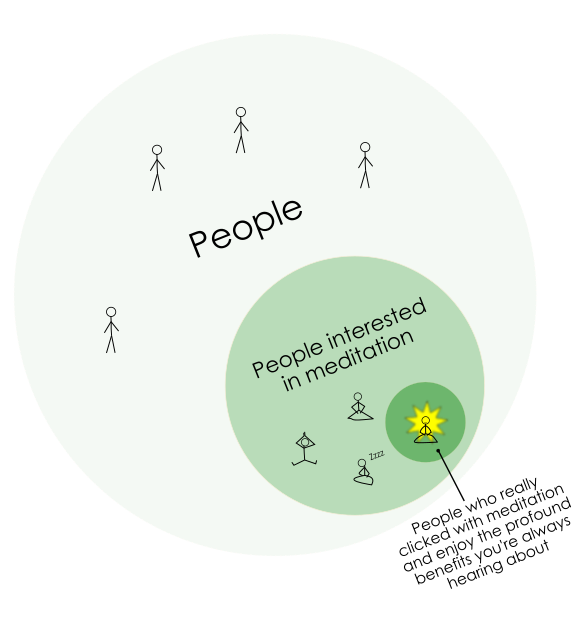
Sometimes they just didn’t stick with it long enough, which can happen with any new hobby. Just as often, though, the motivation is there, but the new meditator hits one of a few predictable (and surmountable) stumbling blocks, and only ever experiences mild benefits.
In this post, I’ll show you how to bypass those obstacles, so that you can be someone for whom meditation “clicks,” and can enjoy everything advertised in the brochure: serious calm, unmistakable equanimity, tangible concentration.
I’ll give you a map for getting past the initial beginner’s hump – that murky, uncertain realm of “Am I doing it right?” and “I think something’s happening, but I’m not sure.”
There is a place, just beyond this hump, where it’s absolutely clear that you’re doing something right. The rewards of quality meditation practice are not subtle.
Think of this post as a guide to finally “getting” meditation – to reaching that unmistakable place where you know what you’re doing, and your whole life is better for it.
Why People Get Stuck
The problem certainly isn’t lack of how-to instruction. Anyone with access to a library or the internet can find comprehensive instructions on hundreds of potent meditation techniques.
I believe the problem has more to do with how we approach the instructions, whatever the technique, and how we respond to uncertainty and doubt.
So I won’t teach a meditation technique in this post. Instead, I’ll give you an almost-foolproof method for getting somewhere with any decent meditation technique, whether it’s from a book, a course, an app, or a stray pamphlet your brother brought home from a silent retreat.
The Most Important Thing You Need to Know
Here’s what every meditation beginner needs to know, regardless of what method they’re using:
Meditation isn’t especially difficult, but you have to learn it without ever seeing how anyone else does it.
Because meditation happens inside people’s heads, there’s no way to learn it by watching others, as we do with most other things. This makes the skill of meditation seem trickier and more mysterious than it really is.
The basic skills that make up meditation techniques are actually pretty simple. For example:
- directing your attention to something
- relaxing needless tension in the body
- returning from distraction without getting upset
- noticing subtle sensations in the body and mind
- allowing experience to unfold without interfering
These skills take some experimentation and practice, but they aren’t any more difficult than the ones involved in gardening, cooking, or anything your employer has trained you to do.
However, meditation comes with this unique additional challenge — because it only happens in people’s heads, you have no way of knowing what “good” meditation looks or feels like.
There are no highlight videos of superstar meditators, performing great meditative feats. Any image you might have of effective meditation will be completely abstract, or based on tropes and stereotypes. I should feel calm, I suppose? Maybe filled with light?
It is an unusual learning situation. Meditation is a skill like any other, but it’s impossible to observe someone doing it, unless that person as you.
That means you can’t emulate anyone, and you can’t see how what you’re doing differs from other meditators. All you can do is work the instructions as you currently understand them, experimenting in good faith until you experience something truly new — perhaps profound and unusual levels of awareness and calm. Then you know you’re on the right track, and you build from there.
This is a phase all meditators must go through. I call it the “Window of Uncertainty.” It begins the moment you first sit down to meditate. It ends the moment you experience clear evidence that you’re doing something right: you feel an unprecedented state of calm, clarity, or equanimity, which leaves no question that what you’re doing is working.
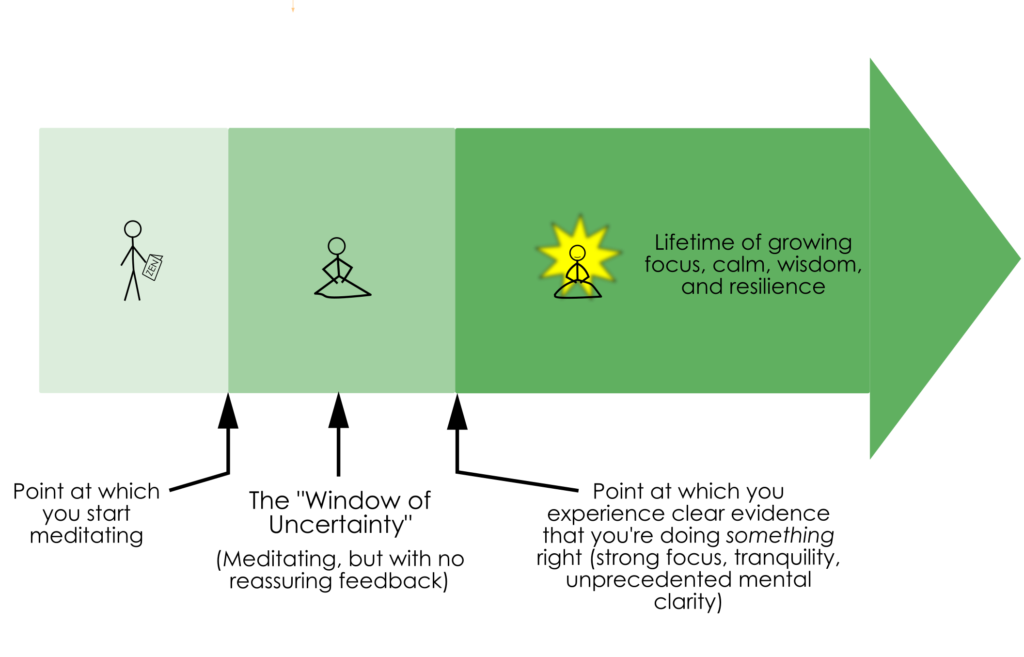
The only way to cross the Window of Uncertainty is to continue to meditate, even though you aren’t totally sure you’re doing it right.
With other skills, it’s more obvious how close you are to success, even when you’re just beginning. If you were learning to shoot a basketball, no matter how unskilled you were, you’d at least know if your shots were going in. If you were making pastries, you’d know if they taste good, and whether they look like the ones at the bakery.
With meditation, you don’t have this immediate feedback to base your adjustments on. You could be doing the technique just fine, without experiencing any immediate changes. Even for experienced meditators, concentration, tranquility, mental clarity, and other obvious signals of good practice take time to show up. That means the absence of those qualities doesn’t tell you anything, the way missed baskets or burned pastries would.
We’re accustomed to having this immediate feedback while we learn. That’s why most new meditators assume they’re making some kind of mistake unless they feel calm, focused, and equanimous.
The first thing you’ll probably notice, in your first meditation session, is that you aren’t calm or focused. Already this is a small success – you’re becoming more aware of your experience – but it feels like failure, because you don’t know what could signal success except for calm and focus.
The solution is to acknowledge this unique absence of immediate feedback, to embrace the Window of Uncertainty as an interesting part of your journey. You get to explore the unmapped mind and learn how it works, knowing that you will, sooner or later, hit on something amazing.
Mostly that means learning to refrain from trying to make yourself feel calm and focused, which is the tendency of virtually everyone at first. Instead, you simply do the practice to the best of your current understanding, and ask questions when something is particularly confusing.
That is enough to get you across the Window of Uncertainty.
Here’s what this approach looks like as a complete map:
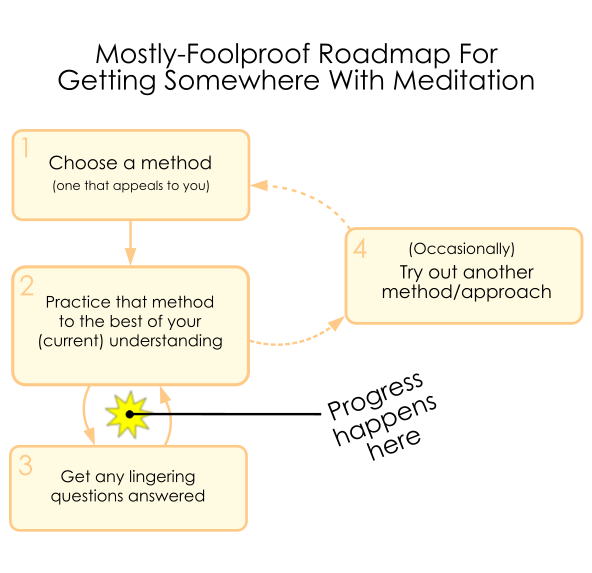
You choose a method that seems okay to you. You do it to the best of your understanding, which will naturally be a beginner’s understanding. You seek answers to your most pressing questions, which provides clarity and saves you a lot of trial-and-error work.
Doing only that, your understanding will deepen, and your practice will become more effective. Then you’ll have new questions, and so on.
At a certain point, you receive that clear feedback that confirms you’re on the right track – it becomes markedly easier to focus, background sound seems to sparkle, and you feel settled and still in a way you seldom do in ordinary life.
Congratulations. You’re over the hump and on your way.
The four steps of the roadmap can use some elaboration.
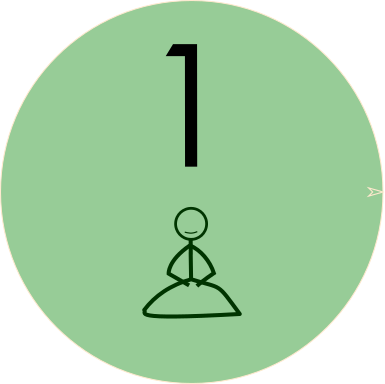
Step 1: Choose a Method
There are literally hundreds of tried-and-true meditation methods.
At first, they seem very different from each other. In one you might focus on breath sensations at the tip of the nose. In another, you recite a word in your head repeatedly, and focus on that. In some styles you leave your awareness wide open, noting whatever arises. There’s even one where you stare at a candle, then close your eyes and focus on the afterimage.
These are essentially different ways of developing the same skills and sensitivities: concentration, equanimity, and the ability to detect subtle sensory experiences. Different methods vary more in the type of language they use, and the skills they emphasize, than in what they will ultimately do for you.
In my experience, a given person will click more easily with some approaches than others. Each of us naturally resonates with different analogies, concepts, and instructional styles. When you first start, however, you have no idea which one will click the quickest for you, so don’t worry about it. Just choose a method that appeals to you.
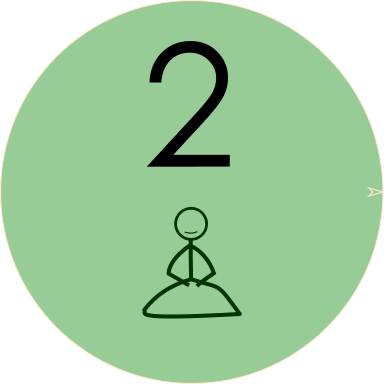
Step 2: Practice that method to the best of your (current) understanding
In meditation, because there’s no immediate feedback, beginners tend to assume they’re doing it wrong, which leads to one of two things:
- Becoming so uncomfortable with the idea of meditating wrong that they stop doing it at all
- Trying to force themselves to feel calm and focused (which is never part of the instructions)
All that’s necessary is to practice your method to the best of your understanding right now. Your level of understanding will naturally improve, as you make the inevitable little discoveries that happen with experience:
- Ah, it’s much easier to stay with the breath if I focus on it more gently.
- Ah, *that’s* what they mean when they say, ‘Allow body sensations to come and go.’
- Ah, I was tensing my legs the whole time and didn’t realize it. It’s way easier when I relax them.
Even though you may not yet be experiencing obvious states of concentration or tranquility, your skills are already improving. The next time you sit down to practice to the best of your understanding, that understanding has already improved. You’re advancing across the Window.
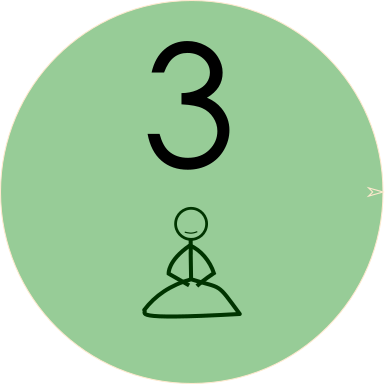
Step 3: Get your questions answered
Like any other skill, success in meditation isn’t purely a matter of following the instructions, it’s discovering what the instructions are pointing you to.
A major-league hitter could give you the most detailed instructions possible on how to hit a fastball — where to grip the bat, when to shift your weight, how to read the pitch. But the real learning happens by feeling your way into those movements, and discovering, in your own experience, what the hell he’s talking about.
However, anything he could tell you might still be extremely helpful, cutting down on what you have to figure out through trial and error. With a single question, you could eliminate a major point of confusion, and make every at-bat better — for the rest of your life.
In my experience, this is what most beginners don’t do in meditation, and I’m not quite sure why. We do it with everything else we’re trying to learn. My best piece of advice on learning meditation might be just that: seek answers to your questions.
Everyone has questions, it’s just a matter of whether they get asked.
- How do I stop thinking?
- When I focus on my body, I don’t like what I feel. What do I do?
- Is it okay to scratch an itch while I’m meditating?
Without asking questions, you’re doing a lot of unnecessary work. A person could meditate for weeks without knowing whether it’s okay to swallow their saliva during meditation. (It is, and the moment you know that, meditation becomes a far more comfortable experience.)
As for where to get answers, it depends on the source of the instructions you’re working with. If you’re working with a teacher, just ask. If you’re working from a book or a course, it might be covered in a troubleshooting section, or you might be able to email the author. Google is also surprisingly effective – most questions have been asked before, and answered online.
Belonging to a meditation community, online or offline, is very helpful for getting questions answered. There are online communities around many popular meditation books, styles, and systems, which can be found by Googling. If possible, find a community based around the style or method you are practicing, rather than meditation in general.
You can also ask me meditation questions any time, and I’ll do my best to give you a helpful answer, or point you to a place that might have one.
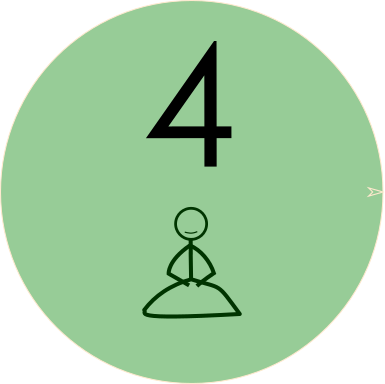
Step 4: Occasionally try out other meditation methods
For a few weeks at least, practice your chosen method at least a little every day.
Again, don’t worry about whether you’re fully “getting it.” You only need to meditate to the best of your current understanding, while making a point of getting any major questions answered.
Now and then, branch out. Try a different method, doing it daily for a while, instead of (or better yet in addition to) your first method. You might try a few guided meditations on YouTube, or perhaps you want to dive into The Mind Illuminated or another thick, comprehensive book.
Do this method in the same way: to the best of your understanding, resolving any major points of confusion by asking questions.
Expanding your repertoire of methods does two things.
Firstly, as we’ve established, different people click with different styles and modes of instruction. By trying a few different techniques, taught by different people, using different analogies and points of emphasis, you’re more likely to find the instructions best worded for your particular brain.
Secondly, any method you learn will illuminate things about every other method. All meditation instructions are ultimately just trying to get you to recognize certain truths about human experience – how your attention works, how you can relate to thoughts and feelings differently, how you can create space between stimulus and response. Your collected insights will come together like a grand puzzle. The more techniques you explore, the better you understand all the others.
The only caution here is not to try a different method every time. Give each one some exploration time.
Getting Started Today
Okay, so we’ve covered a lot.
If you would like to make use of this strange, home-bound phase of our lives to finally become a meditator, following the above roadmap virtually guarantees you will cross into meaningful results relatively quickly.
The main takeaways:
- Meditation isn’t especially difficult, it just lacks the immediate feedback we’re used to (at first)
- All you can do, and all you need to do, is practice a method to the best of your current understanding
- Asking questions can save you a lot of time
- Exploring new methods can create breakthroughs
If you’ve tried meditation before but never clicked with it, you may already have books, apps or courses you can go back to. Try them again as though they’re new, this time with the support of the roadmap.
If you don’t already have a method handy, here are a few I can vouch for:
Good Books:
- Beyond the Breath – Marshall Glickman
- Mindfulness in Plain English – Bhante Gunaratana
- The Mind Illuminated – John Yates / Culadasa
Good Online Instructions:
- Basic Breath Meditation — Thanissaro Bikkhu
- Concentration Meditation — Leigh Brasington
- Receptive Awareness — Andrea Fella [Intro talk] [Guided practice]
- Open Awareness Noting (aka “See Hear Feel”) — Julianna Raye
There are many, many more options out there on the web. Just have your quackery-detector on as you review them.
Notice how greatly instructions can differ, both in the amount of detail they give, and the language they use. This is why you should choose one that appeals to you, and explore a variety over time.
No comments:
Post a Comment